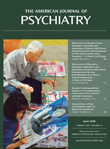Elevated Cerebrospinal Fluid Substance P Concentrations in Posttraumatic Stress Disorder and Major Depression
Abstract
Objective: The authors tested the hypothesis that concentrations of the pain-transmitting neuropeptide substance P are elevated in the CSF of patients with major depression or posttraumatic stress disorder (PTSD), which have overlapping symptoms. The authors also sought to determine if CNS substance P concentrations change on provocation of symptoms in PTSD patients. Method: The authors measured CSF substance P concentrations in medication-free patients with either major depression or PTSD and in healthy comparison subjects. Next, using a within-subject, crossover design, the authors sampled CSF for 6 hours through an indwelling subarachnoid catheter in PTSD patients before, during, and after exposure to a 60-minute traumatic or neutral videotape stimulus. Results: Both depressed and PTSD patients had significantly elevated basal CSF substance P concentrations. In the challenge study, marked increases in CSF substance P concentrations were found only after precipitation of PTSD symptoms. CSF substance P concentrations increased by 169% and 90.6% of baseline levels at 10 and 70 minutes, respectively, after the start of the traumatic videotape but changed by only 1.1% and –8.1% of baseline levels 10 and 70 minutes after the start of the neutral videotape. Conclusions: These results suggest that elevated CNS substance P concentrations are involved in both major depression and PTSD. The marked increase in CSF substance P concentrations during and after the symptom-provoking stimulus, but not after the neutral stimulus, implicates CNS release of substance P in the mechanism of acute PTSD symptoms. These data also reveal that CNS substance P responds acutely to psychological stress in humans.



